Prospect Profile: Shedeur Sanders
Colorado quarterback Shedeur Sanders, son of Hall of Fame NFL cornerback and current Colorado head coach Deion Sanders, has been one of the 2025 NFL Draft class’s most polarizing prospects. At times trending to be the No. 1 overall pick in the draft, Sanders’ draft stock has slowly fallen in the last few months, but he still projects as a first-round quarterback and a potential starter in the NFL. 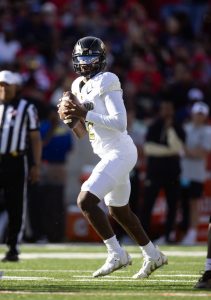
Sanders grew up just outside of Dallas, where his father spent five years of his career from 1995-99. When he got to high school, attending Trinity Christian School in Cedar Hill, Texas, he was coached by his father, who served as the high school’s offensive coordinator at the time. Between the different recruit ranking services, Sanders was either a three- or four-star recruit, with 247Sports ranking him as the 37th-best passer in the class.
Likely based on his pedigree, plenty of schools were willing to take a chance on Sanders as a prospect, granting him offers from several Division I programs. The schools that recruited him the most were Alabama, Baylor, Louisville, LSU, South Carolina, FAU, UCF, and Utah State. He committed to the Owls in Boca Raton in the July before his senior season, but when his father was hired as the new head coach at Jackson State two months later, the Tigers became the favorite to land him. He eventually decommitted from FAU, flipping and signing with Jackson State, who would also flip five-star, No. 1 overall recruit Travis Hunter from Florida State on Early National Signing Day.
After initially being ineligible to perform in football activities during the spring, Sanders was named the starting quarterback for Jackson State as a true freshman. Starting all 13 games, Sanders completed 65.9 percent of his passes for 3,231 yards, 30 touchdowns, and only eight interceptions, winning 11 games. He won the Jerry Rice Award (given to the most outstanding freshman in the FCS) becoming the first player from a historically black college or university (HBCU) to win the award. As a sophomore, Sanders’ Tigers went 12-1 while he completed 70.6 percent of his passes for 3,732 yards, 40 touchdowns, and only six interceptions. He sophomore campaign was rewarded with the Deacon Jones Trophy (given to the nation’s top HBCU player).
In early-December, near the end of the Tigers’ season, Deion was named the new head coach at Colorado. Two weeks later, both Shedeur and Hunter entered the transfer portal and, eventually, followed their head coach to Boulder. The newcomers in Colorado started off hot with three straight wins over a ranked TCU, Nebraska, and Colorado State, but the Buffaloes would go 1-8 in Pac-12 play to finish the season 4-8 (4-7 with Sanders as the starter). Sanders completed 69.3 percent of his passes for 3,230 yards, 27 touchdowns, and only three interceptions as he and Hunter shined as bright spots on a struggling team that desperately needed improvements on the offensive line and defense.
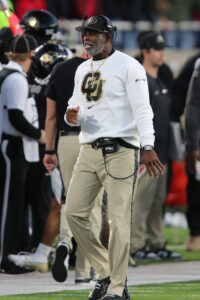 Coming back for his final year of eligibility, Sanders, Hunter, and company went 9-3 in the regular season, ranking 23rd in the College Football Playoff rankings, missing the playoffs. They would go on to lose to BYU in the Alama Bowl to end 9-4. Overall on the season, Sanders set career highs in completion percentage (74.0) and passing yards (4,134) while throwing 37 touchdowns to 10 interceptions. He earned honors as the Big 12 Offensive Player of the Year in the school’s first season in the new conference, and the university would eventually announce that it was retiring both Sanders’ No. 2 jersey and Hunter’s No. 12 jersey.
Coming back for his final year of eligibility, Sanders, Hunter, and company went 9-3 in the regular season, ranking 23rd in the College Football Playoff rankings, missing the playoffs. They would go on to lose to BYU in the Alama Bowl to end 9-4. Overall on the season, Sanders set career highs in completion percentage (74.0) and passing yards (4,134) while throwing 37 touchdowns to 10 interceptions. He earned honors as the Big 12 Offensive Player of the Year in the school’s first season in the new conference, and the university would eventually announce that it was retiring both Sanders’ No. 2 jersey and Hunter’s No. 12 jersey.
At times during the 2024 season, Sanders was thought to be a potential No. 1 overall pick in the draft, often with Hunter being his top competition for the top honor in the class. Over time, Miami’s Cam Ward eventually took over the odds as the favorite to land in Nashville as the top overall draft pick, making Sanders a likely second overall pick. As the pre-draft process continued, Sanders continued to slip with Hunter and Penn State’s Abdul Carter becoming favorites to land at Nos. 2 and 3. While it’s always a possibility that a team could trade up to No. 4 overall to secure Sanders, the latest projections see him potentially falling back to No. 9 overall with the Saints or even No. 21 overall with the Steelers. There are some that view him almost as highly as Ward and some who don’t even give him a first-round grade.
The majority of concerns that have caused Sanders to slide have to do with his tape. Sanders ranks as QB2 (sometimes QB3 behind Ole Miss’ Jaxson Dart) for a reason. His senior year completion percentage led the NCAA, displaying elite accuracy, and he shows impressive abilities stay cool in clutch situations and avoid turnovers despite excessive pressure from a leaky offensive line. He’s smart, savvy, and tough and plays in a really clean rhythm with Colorado’s offensive system, which he knows well.
Some negatives from his game are actually related to some his strengths. His high completion percentage has been linked to an overreliance on quick throws, screens, and checkdowns as only 23.7 percent of his completions at Colorado were on throws over 10 yards. Much of this has to do with a lack of elite arm strength, forcing him to rely on strong timing to float and arc throws in to his receivers with limited zip. When that elite timing falls apart on him, though, he can roll the snowball down the hill, backpedaling into pressure and holding on to the ball too long while trying to make something out of nothing. When plays fall apart, he has a tendency to get ultra-conservative, which avoids turnovers but doesn’t turn negative plays into positive plays, something Ward excels at. A lot of this stems, as well, from a general lack of mobility, a trait he failed to inherit from his father. 
Further concerns were raised about off-the-field aspects. Though Sanders has kept his nose clean off the field, some organizations came away from interviews with Sanders with concerns about his character, whether warranted or not we can’t necessarily say. There were also concerns about his leadership, mentality, and coachability on a team without his father as a coach, considering Deion has coached his son since their time in high school together.
Regardless of these concerns, Sanders has shown that he can overcome his shortcomings to find some success at the collegiate level. It remains to be seen whether he can find that same success without a Heisman winner weapon to throw to or his father as a mentor and coach to support him, but Sanders has done enough at this point to warrant a first- or second-round chance. While Sanders’ elite timing and ability to avoid turnovers makes him one of the most pro-ready passers in the class, he may project best on a team with whom he can sit, learn, and develop, a team with a veteran in place that Sanders can either beat out or learn from.
Later this week, we’ll find out which locker room he’ll be joining. And, in May, when the rookies report to camp, we’ll begin to see just how well he fares out from under the shadows of his father and Hunter.
Prospect Profile: Donovan Ezeiruaku
Boston College doesn’t always act as a pipeline of talent into the NFL, but often, the players they do put into the league (e.g. Matt Ryan, Luke Kuechly, Chris Lindstrom) have potential to be some of the best at their respective positions. Premier pass rusher Donovan Ezeiruaku has potential to do the same for the Eagles as a possible first-round pick this coming Thursday. 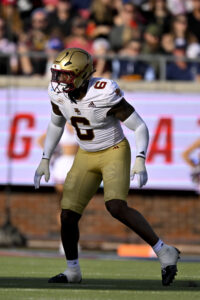
Originally a Philadelphia native, Ezeiruaku grew up and went to high school just half an hour south of the city at Williamstown HS (NJ). Even after leading his high school to back-to-back state championships, Ezeiruaku didn’t have a rank on most recruiting sites. He ended up being ranked as a three-star athlete, with 247Sports ranking him as the country’s 195th-best linebacker.
After getting his second ring at the high school level, Ezeiruaku started to garner some attention, picking up offers from FCS programs like Holy Cross, Stony Brook, and Wagner. His intelligence was on display, as well, as he saw offers come in from Harvard and Princeton. Eventually, FBS offers would arrive with Northern Illinois, Old Dominion, Temple, Boston College, and Vanderbilt all soliciting his services. Without the availability to take visits because of COVID-19, Ezeiruaku committed to head coach Jeff Hafley and the Eagles sight unseen.
As a true freshman, Ezeiruaku didn’t start but played a huge role off the bench, logging three sacks and four tackles for loss in 10 game appearances. Becoming a full-time starter in 2022, he earned All-ACC second-team honors with a breakout season that saw him lead the team in both sacks (8.5) and tackles for loss (14.5). Despite a down season for the Eagles defense the following year, Ezeiruaku still led the team in both categories while only recording two sacks and 6.5 tackles for loss in 13 starts.
Whatever Ezeiruaku lacked in production in 2023, he made up for in his senior season. This past year, Ezeiruaku finished second in the country with 16.5 sacks (behind only Marshall’s Mike Green) and fourth in the country with 20.5 tackles for loss (behind Green, Penn State’s Abdul Carter, and Ohio State’s JT Tuimoloau). Because he played in one fewer game than Green, Ezeiruaku passed him on avergae as first in the country with 1.38 sacks per game (over Green’s 1.33). Similarly, Carter and Tuimoloau both played in 16 games, so Ezeiruaku passed them to finish second in the country with 1.71 tackles for loss per game (behind only Green’s 1.73).
There’s lots to like about Ereizuaku as a pure pass rusher. He has great bend and acceleration during an outside speed rush. He also has a range of pass rushing moves that utilize his lateral mobility and quickness. He also has the flexibility to rush from both sides of the ball. He showed durability throughout his time in Chestnut Hill, starting 36 straight contests after missing three games his freshman year. He also showed leadership characteristics as a team captain in his last two years of school.
Ezeiruaku isn’t a perfect pass rushing prospect, though. Ideally, he needs to add size and strength in order to compete with NFL linemen, particularly since he doesn’t have an effective bullrush move. That lack of muscle moves can limit him if he gets pinned inside on a pass rush. While he’s an elite disruptor, he lacks elite abilities on other parts of the field. He rarely showed an ability to drop into coverage, and if a quarterback or ball carrier slips away from him, he doesn’t have great speed to pursue.
These shortcomings haven’t stopped teams from doing plenty of homework on Ezeiruaku as a potential first-round pick. The reigning ACC Defensive Player of the Year and consensus All-American (the school’s first since running back Andre Williams in 2013) was a hot topic among scouts at the start of the month and has only seen his stock rise from there. While some view him as an early-Day 2 prospect, a run on pass rushers could help Ezeiruaku slip into some first-round money, and with how deep this year’s pass rushing group is, a run is likely to occur.
Prospect Profile: Nic Scourton
While much of the pre-draft focus coming out of College Station this year has been on likely first-round pass rusher Shemar Stewart, teammate of one year and fellow pass rusher Nic Scourton may quietly sneak into the first round with him. According to sportskeeda’s Tony Pauline, Scourton has been getting some buzz as a potential late first-round pick recently with late-round teams like the Eagles and Ravens showing particular interest. 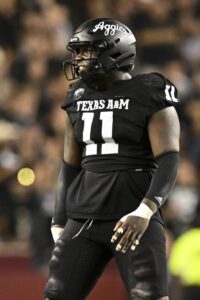
While registering as a consensus four-star prospect coming out of Bryan HS (TX), Scourton only ranked as the 22nd best defensive line prospect in his class, per 247Sports. As a result, Scourton wasn’t recruited by many Power 5 schools coming out of high school. His only in-state offers came from SMU, North Texas, and UTSA, and his biggest offers came from Purdue, Colorado State, Memphis, and Marshall. As his only Power 5 offer, the Boilermakers landed his commitment.
Coming off the bench as a true freshman, Scourton still found a way to make an impact. His 22 tackles were the most for a freshman defensive lineman at Purdue since George Karlaftis three years earlier, and he notched two sacks in the team’s last two games of the year. In 2023, Scourton took on a starting role and graded out as the team’s second-best defender that season, per Pro Football Focus (subscription required). In only 11 games, he led the Big Ten in sacks (10.0) and was fourth in the conference in tackles for loss (15.0), earning second-team All-Big Ten honors.
Coming off his successful sophomore campaign, Scourton opted to jump into the transfer portal for what would seemingly be his final year of collegiate play. Despite their campus being a mere three miles from his high school, Texas A&M didn’t recruit Scourton out of high school, but he overlooked that fact in favor of a homecoming for his junior year, committing to transfer to the Aggies.
Because Stewart struggled to produce throughout his time in College Station, it’s no surprise that Scourton came in and led the Aggies in sacks (5.0) and tackles for loss (14.0) in 2024. Starting 12 games for Texas A&M, he graded out as the third-best player on the Aggies defense and the 48th-best edge defender in the country, per PFF.
Neither ESPN’s Matt Miller nor Dane Brugler of The Athletic have Scourton ranked as one of their top 10 edge defenders. Brugler slots him in at 12th for the position, citing some bad weight and a lack of ideal length on his frame as some issues limiting his ranking. Still, Scourton’s thick build can be beneficial at the next level, granted he puts on the right kind of weight. The size does help him as an above-average run defender, though he still profiles as a pass rusher who could stand to add some more elegant moves to his arsenal.
As Pauline mentioned above, Scourton received a top-30 visit with the Eagles this past Thursday. ESPN’s Adam Schefter noted his presence with the Browns on Tuesday, and Aaron Wilson of KPRC 2 also logged meetings with the Cardinals, Texans, and Patriots.
What most all of these teams have in common is that they reside around the late-first round and early-second round, giving us a good idea of where he could fall in two weeks. While he maybe didn’t capitalize on his lone year back in the College Station area, it seems teams and their scouts are willing to look over this past season to see the potential production he displayed at Purdue in 2023. As a result, he may just find himself being selected in the first round of the 2025 NFL Draft.
Prospect Profile: Tyler Warren
For much of the 2024 college football season, Michigan’s Colston Loveland was viewed as the premier tight end of the 2025 NFL Draft class. A breakout season from Nittany Lions tight end Tyler Warren gradually saw Loveland slip to TE2 as the Warren gained the top slot. 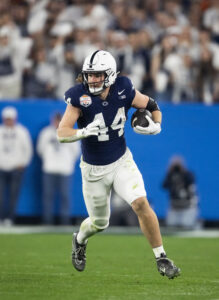
Warren had some decent offers coming out of Atlee HS in Mechanicsville, Virginia. Despite being a three-star athlete and grading as only the 21st-ranked tight end in the class, per 247Sports, Warren fielded offers from Michigan, South Carolina, Virginia, Virginia Tech, Louisville, and Syracuse. He made an early decision, though, committing to James Franklin and Penn State before his senior year and following through on that commitment.
It took a while for Warren to earn some significant snaps in Happy Valley. As a true freshman, Warren retained a redshirt status by only appearing in two games while Pat Freiermuth dominated the room. In his redshirt freshman year, Warren appeared in every contest but only caught five passes for 61 yards and a touchdown while Brenton Strange and Theo Johnson led the group, though Warren did get some gadget use with two rushing touchdowns on six attempts. This continued as the group stayed the same in 2022, though Warren did get three starts in a bit more time, catching 10 balls for 123 yards and three touchdowns.
With Strange departing for the NFL as a second-round draft pick, Warren joined Johnson as one of a two-man tight end attack in 2023. Both players caught 34 passes and seven touchdowns that year, though Warren edged Johnson on yardage 422 to 341. When Johnson was selected in the fourth round of the draft that year, it became clear that Warren would be a name to watch for this year’s class following his redshirt senior season.
Warren blew up the scene this year. With no other tight ends to vulture targets from him, Warren became the Nittany Lions’ top offensive weapon, leading the team in receptions (104), receiving yards (1,233), and receiving touchdowns (8). Though he had the added benefit of a 16-game schedule, thanks to the College Football Playoff, Warren’s 1,233 receiving yards were seventh-most in the NCAA this year. Per Pro Football Focus (subscription required), Warren graded out as the second-best tight end in college football, behind only Harold Fannin Jr. of Bowling Green, who led all of college football in receiving yards and receiving yards per game regardless of position.
Measuring out at the NFL Scouting Combine at 6-foot-5.5 and 256 pounds, Warren is a little undersized for the perfect prototype, but his top-end production is enough to overlook that drawback. His size does limit him as a blocker, where he has plenty of room for improvement, and too easily can he be redirected from his route when in physical coverage, but sheer competitiveness and athleticism often helps Warren play through the contact and dominate, regardless.
Warren’s top competition in the draft is Loveland, Fannin, and Miami’s Elijah Arroyo. Loveland gained national recognition during the Wolverines’ national championship season but didn’t dominate statistically like Warren and Fannin in 2024. Arroyo’s stock continues to rise after a breakout season with the Hurricanes and a show-stealing performance at the Senior Bowl, though an injury at the event held Arroyo out from further improving his stock at the combine.
According to Tony Pauline of sportskeeda, the Jets are a team that are “infatuated with Warren” at the No. 7 overall pick. With the departure of Tyler Conklin to the Chargers, New York could certainly be on the lookout for a tight end in the draft. If they really love Warren, that pick makes too much sense. If he falls past the Jets, though, the Colts are another team that is highly covetous of Warren at No. 14 overall. Indianapolis was high on Brock Bowers last year before he got selected two slots above them. They’ll hope they don’t miss on Warren, too, since they haven’t had an impact tight end since Eric Ebron‘s big season in 2018.
Prospect Profile: Bo Nix
Quarterback has been a position of significant intrigue ahead of the 2024 NFL Draft. The least intriguing piece is USC’s Caleb Williams, who has been slotted into the No. 1 overall pick pretty much since the end of the 2023 NFL Draft. For several weeks now, a prediction that three other quarterbacks (LSU’s Jayden Daniels, North Carolina’s Drake Maye, and Michigan’s J.J. McCarthy) are expected to occupy the three picks immediately following the presumed selection of Williams, in some order. After those four, only two other names have been mentioned as potential first round passers: Washington’s Michael Penix Jr. (who received a Prospect Profile a month ago) and Oregon quarterback Bo Nix. 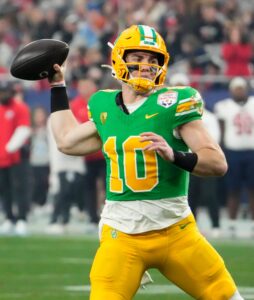
Nix started off his high school career at Scottsboro School (Alabama) before following his father, former Auburn quarterback Patrick Nix, who had just been hired as the head coach at Pinson Valley HS (Alabama) closer to Birmingham. A fractured left ankle kept the younger Nix from thriving in his first year at the new school, but he made a return in time to lead Pinson Valley to a state championship title. He absolutely dominated his senior year, leading his school to their second straight state title and getting ranked by 247Sports as the nation’s 62nd best overall recruit and second-best dual-threat quarterback behind Daniels. Other recruiting services had him as a five-star quarterback and the top dual-threat passer in the nation.
Sitting smack dab between Alabama and Auburn, Nix was recruited heavily by both programs. It did not take much to persuade Nix, though, as he committed to his father’s alma mater before his senior season even began, never wavering from following in his father’s footsteps. Nix enrolled early for the Tigers and quickly beat out Joey Gatewood and Malik Willis for the starting job as a true freshman. Despite early growing pains, namely his 57.6 completion percentage, Nix shined in his first year leading the team, earning SEC Freshman of the Year honors. While Nix displayed some ups and downs over the next two years, his numbers continued to improve despite having three different offensive coordinators. The team success did not improve, though, as the Tigers went 12-9 with Nix starting in those two years.
After a broken ankle ended his 2021 season, Nix let it be known that he was miserable under new head coach Bryan Harsin, who didn’t coach in 2023 after being fired part-way through the 2022 season, and entered the transfer portal. Nix committed to Oregon, reuniting with Kenny Dillingham, who had been his offensive coordinator during his freshman year at Auburn. Thanks to COVID-19, Nix now had six years to play five seasons, meaning he had two years of eligibility remaining with the Ducks.
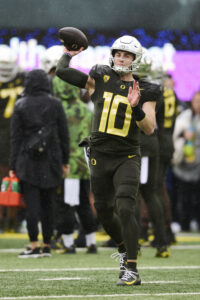 Nix exploded in his first season at a new school. For the first time in his collegiate career, Nix eclipsed a 70 completion percentage (71.9), 3,000 passing yards (3,593), 20 passing touchdowns (29), 500 rushing yards (510), and 10 rushing touchdowns (14). He was an honorable mention All-Pac-12 selection as he set the school record for highest completion percentage at a school that produced such quarterbacks as Marcus Mariota and Justin Herbert. His senior year saw him take off even more, beating his prior year passing numbers with a new record-77.4 completion percentage, 4,508 passing yards, and 45 touchdowns to just three interceptions.
Nix exploded in his first season at a new school. For the first time in his collegiate career, Nix eclipsed a 70 completion percentage (71.9), 3,000 passing yards (3,593), 20 passing touchdowns (29), 500 rushing yards (510), and 10 rushing touchdowns (14). He was an honorable mention All-Pac-12 selection as he set the school record for highest completion percentage at a school that produced such quarterbacks as Marcus Mariota and Justin Herbert. His senior year saw him take off even more, beating his prior year passing numbers with a new record-77.4 completion percentage, 4,508 passing yards, and 45 touchdowns to just three interceptions.
If stats were the sole determining factor for who would go No. 1 overall in the NFL draft, Nix would be the unanimous selection. In 2023, Nix’s 77.4 completion percentage led all of college football. It wasn’t just a school record, it broke Mac Jones‘ FBS record for single-season completion percentage. Nix was second in the FBS in passing yards only behind Penix (4,903) last season. He let the nation in passing touchdowns, and while some full-season starters like Florida State’s Jordan Travis and Penn State’s Drew Allar had few interceptions (2), neither were producing near the yardage and touchdowns of Nix. But scouts and coaches focus on much more than numbers when it comes to the draft.
Physically, Nix is not the prototype for a quarterback, but his body type works for the game he plays. While Nix set records with his arm this year, he still projects best as dual-threat passer. Some of his best throws come on the run and without his feet set, and he uses strong footwork to avoid tacklers in a collapsing pocket. He benefited from most of his production coming off quick, one-look passes, but those plays fit his quick release and strong arm.
Nix still showed the ability to throw all over the field and was productive using play fakes to open routes up down the field. He is a strong runner and, though he did sustain a pair of ankle injuries through high school and college, any questions of his toughness were put to rest when he broke Colt McCoy and Kellen Moore‘s NCAA records for most starts in a career for a quarterback with 61.
So, why isn’t Nix going No. 1 overall? Mainly, quarterbacks with Nix’s style of play have not generally fared well in the NFL. They have not fared poorly (see Mariota, Baker Mayfield, Tyrod Taylor), but they never really stick out around the league’s best. Coaches have nitpicked a lack of patience that does not allow routes to develop and open up. Nix also can rely on his great arm strength as a catch-all, affecting his accuracy and forcing his receivers to make some uncomfortable grabs. Teams also will not like that he is 24 years old entering the NFL draft. It’s not quite on the level of Brandon Weeden (the NFL’s oldest-ever first-round pick at 28 years old), but he’s already the same age as Trevor Lawrence. 
Nix presents a mixed bag coming into the draft. He provided outstanding production through the air and on the ground at the collegiate level. Though his style of play isn’t tailormade for the NFL, Nix has proven to be very coachable. After three different coordinators in his first three seasons and a change of schools, Nix continued to improve year after year, going from a 57.6 completion percentage as a freshman to the FBS record-holder in the stat. He has been lauded for his academics and leadership with his coaches calling him “another coach” on the field, and he only got better each year.
There is plenty to suggest that Nix could struggle to be elite at the next level, but with his tools and drive, it’s hard to imagine that he won’t get a chance as a starter at some point.
Now, where does a player like that go in the draft? Most see Nix as a likely Day 2 pick, though an early run of quarterbacks could force a team’s hand if they truly want Nix, and there isn’t an absence of teams who do. According to Albert Breer of Sports Illustrated, there is an assumption in league circles that, if Nix goes in the first round, it will be to the Broncos. While some speculate that Denver could trade up to select McCarthy, many like Nix better as a stylistic fit with head coach Sean Payton. The Broncos do not have a second-round pick, so they may opt to trade back from No. 12, collect more draft capital, and draft Nix to compete with the newly acquired Zach Wilson.
ESPN’s Adam Schefter warns not to dismiss the Rams, either. Schefter points to general manager Les Snead, who was a graduate assistant coach at Auburn in 1993, when Nix’s father, Patrick, was the Tigers’ quarterback. With some speculation that Penix could be the fifth passer coming off the board as high as No. 8 overall, do not rule out Los Angeles taking Matthew Stafford‘s heir apparent at No. 19.
The speculation does not stop there. With mere days remaining until the draft begins, there is no shortage of possibilities for how the event may play out. Nix could join the others in the first round, or he could freefall into the middle of the draft. Regardless, some NFL team should be adding a coachable, fast-learning competitor later this week.
Prospect Profile: Laiatu Latu
The NFL world is lucky that it will soon have the opportunity to watch UCLA edge rusher Laiatu Latu. The deadly pass rusher almost passed up a football career after leading his high school to two national championships in rugby. After briefly considering an international career as a professional rugby player, Latu made the decision to go to college for football and is now preparing to receive a call this Thursday from an NFL coach or general manager. 
Latu was a consensus four-star recruit out of Jesuit HS in Carmichael, CA, with 247Sports ranking him as a top-100 recruit and a top-five weakside defensive end in the country. Latu received all the major college football offers before narrowing it down to an all-west coast top-five of Cal, Oregon, USC, UCLA, and Washington. Latu committed to the Huskies as their third-best recruit in the Class of 2019 behind only Trent McDuffie and Puka Nacua.
As a true freshman, Latu failed to see the field much at all as a reserve and special teamer. In the runup to the 2020 season, Latu suffered a serious neck injury and was eventually told he would have to medically retire because of the ailment. After seeking out the opinion of the doctor who performed Peyton Manning‘s neck surgery back in the day, Latu was medically cleared to play again.
During his rehabilitation, Latu returned to the rugby pitch. Once again, the young athlete was given the opportunity to go pro, receiving a contract offer from the Seattle Seawolves, but yet again, Latu refused to give up on his dream of playing football. He entered the transfer portal and found his way back to his home state with the Bruins, following his position coach at Washington, Ikaika Malloe, whom Latu saw as a bit of a father figure.
In his debut season at UCLA, Latu exploded coming off the bench. Despite not starting a single game, Latu led the team in both sacks (10.5) and tackles for loss (12.5) on his way to first-team All-Pac-12 honors. Last season, as a full-time starter, Latu improved on both of those numbers, leading the Pac-12 in sacks (13.0) while leading the nation in tackles for loss (21.5). Not only did Latu return to the All-Pac-12 first team in 2023, but he was also the conference’s Defensive Player of the Year and a consensus All-American. On top of his ability to bring opponents down behind the line of scrimmage, Latu was disruptive in other ways with five forced fumbles, five passes defensed, and two interceptions during his two years in Los Angeles.
Latu is a pass-rush specialist. With 129 total pressures in 25 games, NFL teams will be licking their chops to add the 23-year-old to their defensive front. He’s wily and effective in putting together his pass-rush moves. His hands are quick and strong, helping him beat any player in his path with rips, clubs, and punches. He is quick off the line, and his elite flexibility helps him to get around tackles on the outside with ease. He’s used to getting double teams and still finds ways to be productive. Latu keeps his eyes on the backfield, helping him to rack up those TFLs, and he uses the drive and aggression from his rugby days to pursue ball carriers all over the field. He also showed athleticism dropping back in coverage, and the coaches at UCLA claim he could have been their best tight end if they had played him both ways.
Latu’s biggest red flag is going to be his medical history. The two-and-a-half-year sabbatical from football due to the neck injury could scare some teams off, though they’ll all have done their homework on the situation at this point in the process. On the field, though, he could stand to improve in his run defense. He’s great at identifying the play but can too easily be erased when runs are designed to go right at him, and he misses too many tackles.
Alabama’s Dallas Turner has long been viewed as the top edge rusher in a class that maybe isn’t as strong as groups of the past. Latu has already worked his way up the draft board, passing Penn State’s Chop Robinson and Florida State’s Jared Verse to get to the second spot on most draft boards at the position. As the draft gets closer and closer, front offices are starting to become enamored with Latu’s disruptive abilities. There isn’t a better pure pass rusher in this draft, and with the ability to play standing up or with a hand in the dirt, he could go to nearly any team and become their sacks leader as a rookie.
Prospect Profiles: Adonai Mitchell, Xavier Worthy
While LSU’s top-ranked duo of Malik Nabers and Brian Thomas Jr. have garnered plenty of press so far and Florida State’s duo of Keon Coleman and Johnny Wilson have seen a drop in their respective draft stocks, it might be time to shine a spotlight on the two receivers coming out of Austin who both have a chance to hear their names called on Day 1 of the 2024 NFL Draft (Washington’s trio of Rome Odunze, Ja’Lynn Polk, and Jalen McMillan may require a profile in the future, as well).
Junior Longhorns Adonai Mitchell and Xavier Worthy have a chance to be the first Texas receivers drafted in the first round of the NFL Draft since Roy Williams in 2004. This would also make Mitchell and Worthy the third and fourth first-round receivers for the Longhorns in their storied history (Lam Jones, No. 2 overall to Jets in 1980). 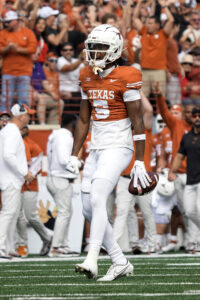
Texas hasn’t had the greatest history with sending wide receivers to the NFL. Since 2008, players like Limas Sweed (second round, 2008), Jordan Shipley (third round, 2010), and Collin Johnson (fifth round, 2020) have failed to make an impact at the NFL level. Third-round picks Marquise Goodwin (2013) and Devin Duvernay (2020) are really the only pass-catchers since Williams to make a name at the professional level, though Goodwin only has one season over 432 yards in an 11-year career and Duvernay’s biggest impact has been as an All-Pro return man. Mitchell and Worthy have a chance to change the trends of their school’s history at the next level.
Worthy was a top-100 recruit in the Class of 2021 out of Central East HS (California) in Fresno. After a breakout junior year, Worthy began fielding offers from college football’s best. Despite offers from Alabama, Auburn, Georgia, LSU, and others, Worthy committed to Michigan. He initially intended to enroll early alongside quarterback signee J.J. McCarthy, but trouble meeting Michigan’s academic requirements led Worthy to defer his enrollment until June. He still found an apartment in Ann Arbor, though he couldn’t work out with the team, but moved back home to explore other options after a month, decommitting from the Wolverines in the process.
Worthy had originally chosen Michigan over the Crimson Tide, who had then-offensive coordinator Steve Sarkisian. When Sarkisian was hired as the Longhorns’ head coach in 2021, Worthy committed sight unseen. Worthy immediately made an impact as a true freshman, leading the team by healthy margins with 62 catches for 981 yards and 12 receiving touchdowns. The next highest totals were 26 catches (Jordan Whittington), 377 yards (Whittington), and four touchdown catches (Bijan Robinson). He finished as a Freshman All-American, first-team All-Big 12 selection, and Big 12 Offensive Freshman of the Year.
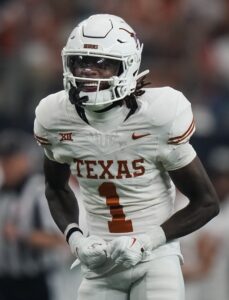 Worthy’s production dipped a bit as a sophomore as Whittington and tight end Ja’Tavion Sanders, who had redshirted in 2021, ate into some of his production. Still, Worthy led the team in catches (60), receiving yards (760), and receiving touchdowns (nine) while earning second-team All-Big 12 honors. It was more of the same last year for Worthy. Once again, he led the team in receptions (75) and receiving yards (1,014), but he was eclipsed in receiving touchdowns (five) by the newcomer Mitchell.
Worthy’s production dipped a bit as a sophomore as Whittington and tight end Ja’Tavion Sanders, who had redshirted in 2021, ate into some of his production. Still, Worthy led the team in catches (60), receiving yards (760), and receiving touchdowns (nine) while earning second-team All-Big 12 honors. It was more of the same last year for Worthy. Once again, he led the team in receptions (75) and receiving yards (1,014), but he was eclipsed in receiving touchdowns (five) by the newcomer Mitchell.
Mitchell was a rare situation of a high school reclassification. Where it’s common to sometimes see recruits reclassify to enter college a year early, Mitchell reclassified from the Class of 2020 to the Class of 2021 in high school, spending his gap year training. Growing up in the Houston area, Mitchell transferred from Westbury Christian School (Texas) to Ridge Point HS (Texas) in order to get more recruiting attention. Still struggling to garner offers, Mitchell followed his father, who moved to Nashville, and transferred to Cane Ridge HS (Tennessee) for his senior year before reclassifying to the Class of 2021.
Shortly after reclassifying, Mitchell committed to Lane Kiffin at Ole Miss. Six months later, though, as the offers continued to roll in, Mitchell flipped to Georgia and then-offensive coordinator Todd Monken. He joined the Bulldogs as a three-star recruit, the 60th best wide receiver in the class, according to 247Sports.
As a freshman, Mitchell was part of a balanced wide receiving corps. While tight end Brock Bowers led the team in every receiving category, Mitchell’s stat line of 29-426-4 (catches-yards-touchdowns) was very similar to then-sophomore Jermaine Burton (26-497-5) and redshirt freshman Ladd McConkey (31-447-5). Mitchell also caught the go-ahead touchdown in the team’s National Championship victory. In his sophomore season, Mitchell was limited to only six games with a left ankle injury. He had nine catches for 134 yards and three touchdowns.
While in school in Georgia, Mitchell’s parents had been looking after his daughter (born the summer before his freshman season). After winning two championship rings with the Bulldogs (and missing most of his sophomore year), Mitchell opted to transfer closer to his family by enrolling at Texas. In his lone season as a Longhorn, Mitchell finished second on the team behind Worthy with 55 catches for 845 yards but led the entire Big 12 conference with his 11 touchdowns.
Mitchell and Worthy present as two different types of receiving options coming out of Austin. At just over 6-foot-2, 205 pounds, Mitchell is a bigger target with a wider catching radius. Mitchell doesn’t sacrifice speed or explosiveness for his size, though. At the NFL scouting combine, Mitchell put up a 4.34-second 40-yard dash, a nearly 40-inch vertical jump, and an 11-foot-4 broad jump. He has above-average acceleration to get him to that elite top speed and uses impressive agility and control in his routes to create separation with stutter routes and by lagging into open areas of coverage. He shows that extra gear when the ball is in the air and has good body control to make adjustments on the ball. When he’s not the quarterback’s target (he was not a high-volume target in college), he’s always looking for someone to block.
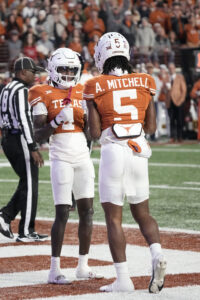 Mitchell will need to get stronger at the next level, though. With his lean form, Mitchell can get bullied by more aggressive cornerbacks. While he has a large catch radius, he has smaller hands and wasn’t elite at reeling in contested catches, though he only had one drop in 2023. He also got most of his yardage without the ball in his hands, only averaging 3.2 yards after catch this season, displaying a lack of ability to make tacklers miss as a ball carrier.
Mitchell will need to get stronger at the next level, though. With his lean form, Mitchell can get bullied by more aggressive cornerbacks. While he has a large catch radius, he has smaller hands and wasn’t elite at reeling in contested catches, though he only had one drop in 2023. He also got most of his yardage without the ball in his hands, only averaging 3.2 yards after catch this season, displaying a lack of ability to make tacklers miss as a ball carrier.
Worthy is a bit shorter than Mitchell at just over 5-foot-11. He’s also slight at just 165 pounds. Similar to Mitchell, Worthy had impressive explosiveness with a 41-inch vertical and nearly 11-foot broad jump. Elite speed is what defines Worthy and gives him a chance to be a first-round pick.
You’ll know the name “Worthy” because he broke the NFL scouting combine’s record for the fastest ever 40-yard dash a month and a half ago. Worthy covered the distance in a record-breaking 4.21 seconds. His speed will be his biggest asset at the NFL level. He has great agility to make cuts in his route-running and his speed makes coverage with a cushion a necessity, though often a futile one. He shows good ball-tracking on deep routes and has a good ability to make tacklers miss with start-and-stop jukes. While the smaller wideout can get knocked back at contact, his low center of gravity and strong balance helps him stay on his feet often.
His size will limit him at the next level, though. Despite his impressive vertical jump, he doesn’t show that ability on the field to climb the ladder for high throws. He doesn’t have a strong ability to make contested catches, either, and focus is often an issue that leads to drops, fumbles, and muffed punts.
Despite their weaknesses, both Mitchell and Worthy project as late-Day 1 or early-Day 2 draft picks. Mitchell has great speed with an ideal frame, provided he can put on some muscle. He also displayed a clutch gene in college, often making the biggest plays at crucial moments. His effort and athleticism will draw the attention of several clubs in the mid-to-late first round.
Worthy is much more of a specialty player at the next level, but that certainly doesn’t mean he can’t find success. He was already a second- to third-round projected pick, but his record-breaking speed may be enough to elevate him to the late-first round. Even if team’s balk at some of his shortcomings, Worthy’s speed and special teams prowess (he led the NCAA in punt return yards this season) guarantee him a draft selection in the first two days. Together, the duo will work to change the reputation of pro Longhorn receivers.
Prospect Profile: Quinyon Mitchell
With these Prospect Profiles, we generally like to shine a spotlight on players who haven’t constantly been thrust into the national spotlight, prospects you likely haven’t been watching on primetime television. Enter Toledo cornerback Quinyon Mitchell.
Toledo went eight years (2009-2016) with zero players drafted into the NFL. The Rockets exploded back onto the scene in 2017 with three players getting drafted, starting with former Chiefs third-round pick Kareem Hunt. Including the 2017 picks, Toledo has sent nine players to the NFL through the draft since then, featuring impact players like Hunt and Diontae Johnson. Mitchell has the chance not only to extend that recent lineage, but also to become the Rockets’ first Day 1 draft pick since Dan Williams in 1993.
Mitchell’s lack of a spotlight dates back to his early days in high school. Despite residing in the talent-rich state of Florida, Mitchell found himself at Williston HS, a small, 1A school south of Gainesville. Lost in the dregs of high school recruits, Mitchell was a consensus three-star athlete ranking so far down the boards that he avoided the attention of the state’s big three (Florida, FSU, Miami). 247Sports.com ranked Mitchell as the nation’s 114th best cornerback recruit.
Mitchell raked in a number of small school offers from the likes of Alcorn State, Georgia State, Georgia Southern, South Dakota, and South Alabama before landing a couple offers from in-state FAU and USF. At a satellite recruiting camp, visiting Toledo coaches took note of Mitchell and delivered an offer. He committed to the Rockets, but a senior year offer from Illinois led Mitchell to consider his options before ultimately sticking with Toledo and heading north to Ohio.
At Toledo, academic struggles forced Mitchell to grayshirt his freshman year before the COVID-19-shortened 2020 season kept him mostly quiet in 2020, as well. Following the slow start, though, Mitchell came on strong as a full-time starter in 2022. Through the final three years of his college experience, in fact, Mitchell didn’t miss a single start, playing through a couple minor injuries to make 40 straight starts.
In his second season as a starter, Mitchell exploded onto the scene. While leading the MAC in interceptions with five, two of which were returned for touchdowns, Mitchell earned first-team All-MAC honors. But he caught the national eye after leading the country in passes defensed with 25, helping him to earn second-team All-American honors. He followed that up with a strong 2023 season, as well, in which he recorded one interception and 19 passes defensed (leading the MAC) and earned the same All-MAC and All-American accolades.
His elite ability to break up passes occurred all over the field. Not only did he display the speed and stickiness to stay with receivers down the field, but he also showed off an elite ability to read the quarterback and receiver and drive upfield to break up short comebacks and screens. He may have the best ball skills of any defensive back in this year’s draft. What’s almost as impressive as what he did with those skills, though, is what he didn’t do. Mitchell’s elite coverage was accompanied by elite restraint. During his two second-team All-American seasons, Mitchell drew only one penalty (a pass interference call in 2022).
It difficult to find holes in Mitchell’s game. The glaring red flag is obviously the lack of competition, though he did face off against a number of talented receivers, including top wide receiver prospect Marvin Harrison Jr., who beat him for a touchdown in 2022. There could be concern that Mitchell may not hold up as well against top-end receiver talent on a consistent basis. Also, due to the lack of talent around him, there isn’t a ton of film on Mitchell in hard press coverage. In order to help cover more of the field, Mitchell was often in zone or off-man coverage. Teams will want to get him coached up on press techniques early. Similarly, Mitchell lacks experience in the slot, playing almost exclusively on the outside in college.
At the NFL scouting combine, Mitchell only improved his draft stock. He showed off speed that we already knew was there with a 4.33-second 40-yard dash. He also displayed a surprising strength and explosiveness in the bench press and jumps that, while not elite, were very impressive. Everything he did in Indianapolis was just a confirmation of what he’s put on film at Toledo for the last two years.
Mitchell is almost certain to become the Rockets’ first first-round selection in 31 years. Both ESPN’s Matt Miller and Dane Brugler of The Athletic have Mitchell ranked as the second-best cornerback prospect in the 2024 NFL Draft behind only Alabama’s Terrion Arnold. Brugler ranks Mitchell as the draft’s 11th best prospect, while Miller ranks him slightly lower at 15th.
Mitchell is an NFL-ready cornerback likely to start immediately wherever he is chosen to go. Team’s will be tempted to utilize his elite abilities on special teams, something he excelled at with Toledo, but his elite speed and ball skills will immediately become a factor on some mid-first round team’s defense. Mitchell is finally about to step into the spotlight, and how he handles it will determine whether or not Toledo has produced another unexpected NFL contributor.
Prospect Profile: Cooper DeJean
The University of Iowa has been a bit of a surprise team of late with a number of former Hawkeyes going pro and making a big impact in the NFL. Joining the ranks of Lukas Van Ness, Jack Campbell, Sam LaPorta, Tyler Linderbaum, and Tristan Wirfs, junior cornerback Cooper DeJean is expected to be the next Iowa alum selected early in an NFL draft.
DeJean grew up in Iowa as a multi-sport athlete, excelling in baseball, basketball, track, and football. At OABCIG HS in Ida Grove, Iowa, DeJean was a star athlete on the gridiron, playing wide receiver, quarterback, and defensive back while also returning punts. He earned All-State honors as a receiver his sophomore year and then led his team to undefeated, state championship seasons at quarterback the following two years.
 Despite ranking as a consensus four-star recruit and a top-ten safety in the nation, according to 247sports.com, DeJean only garnered one FBS offer. His first offer came from Iowa Western CC before he earned offers from FCS programs like Illinois State, North Dakota State, South Dakota State, and Northern Iowa. He earned his first and only FBS offer from the Hawkeyes following a Junior Day visit and committed two months later.
Despite ranking as a consensus four-star recruit and a top-ten safety in the nation, according to 247sports.com, DeJean only garnered one FBS offer. His first offer came from Iowa Western CC before he earned offers from FCS programs like Illinois State, North Dakota State, South Dakota State, and Northern Iowa. He earned his first and only FBS offer from the Hawkeyes following a Junior Day visit and committed two months later.
At Iowa, DeJean played sparingly as a freshman, appearing in seven games and making one start but staying mostly off the stat sheet. His sophomore season was a different story as he exploded onto the scene. Starting all 13 games in his second season with the Hawkeyes, DeJean finished the season with second-team All-Big Ten honors after leading the team with five interceptions and 13 passes defensed while playing across from Broncos cornerback Riley Moss. DeJean demonstrated his return abilities on those interceptions, returning three of them for touchdowns. He also demonstrated his return abilities on returns, averaging 16.5 yards per return on ten punts fielded.
DeJean’s junior year at Iowa was similarly impressive. He received first-team All-Big Ten honors as both a defensive back and punt returner while also being named Big Ten DB of the Year and Big Ten PR of the Year. On 21 punt returns, DeJean had 241 return yards and a touchdown. Seeing far fewer targets, DeJean continued to produce as a cornerback with two interceptions and seven passes defensed, but a broken fibula in his right leg in November would require season-ending surgery that sidelined him for the remainder of the year and for the pre-draft process until very recently.
This past week, DeJean was able to host a private workout for scouts. He demonstrated an impressive explosiveness on his vertical and broad jump and clocked in at 4.42 seconds (unofficial) for his 40-yard dash, per Jeff Risdon of USA Today. The mini-pro day did much to prove that his recovery was progressing well and that the injury likely won’t be a factor in his rookie season.
DeJean is slightly shorter than the prototypical cornerback size (just over six feet tall), but as an athlete who was moved around to safety and hybrid roles in Iowa City, he has decent size to go along with his above average speed. His reaction time can be a hindrance at times, but he often masks it with great anticipation. His playing experience as a quarterback, receiver, and cornerback gives him a unique insight that allows him to anticipate better than most other defenders. He’s one of the better tackling cornerbacks in this draft and plays physical even when the opponent is not carrying the ball. His combination of speed and physicality allow him to use a variety of man coverage techniques with success. His lack of solid reaction time leads to the occasional overrunning of a route, and he can get grabby to avoid losing coverage, but these are rare occasions in what is usually stellar coverage.
ESPN’s Matt Miller ranks DeJean as the fourth-best cornerback and the 26th-best prospect overall. Dane Brugler of The Athletic seems to agree, slotting DeJean as the fourth-best corner and the 25th-best prospect overall. DeJean seems like a no-brainer in the mid- to late- first round. He shows versatility with experience playing all over the secondary and becomes an immediate special teams asset as a rookie. DeJean will hope to land with a team who can utilize him early and often as he attempts to join LaPorta, Linderbaum, and George Kittle as the most recent Pro Bowl Hawkeyes in 2024.
Prospect Profile: Michael Penix Jr.
At this point, it’s starting to become extremely clear who we should be expecting to see as the first player and quarterback taken in the first round of the 2024 NFL Draft next month. We also know UNC quarterback Drake Maye is fighting off LSU Heisman winner Jayden Daniels as QB2 of the draft and that Michigan national champion J.J. McCarthy and Oregon’s Bo Nix are enjoying their own late surges towards the first round. One other quarterback seems to polarize more than the rest, as Washington’s Michael Penix Jr. continues to work to prove himself as a top football player. 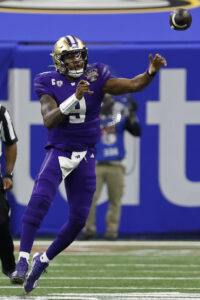
As a three-star recruit out of Tampa Bay Tech HS (Florida), Penix struggled to stand out in the talent-laden state of Florida. He quickly picked up local offers from Group of 5 schools like USF and FAU before attending a camp at Tennessee and earning his first Power 5 offer. 10 months later, after receiving only a few other offers, Penix committed to the Volunteers. After the school’s firing of Butch Jones, the head coach to whom he had committed, Penix decommitted, taking the week before an early National Signing Day to consider his options before ultimately signing to attend Indiana.
Penix would redshirt his freshman year with the Hoosiers, appearing in only three games before tearing his ACL. After returning from his injury, Penix entered his redshirt freshman year as the starter, winning the job over incumbent quarterback Peyton Ramsey. In six starts, Penix led the Hoosiers to a 5-1 start to the season while completing 68.8 percent of his pass attempts for 1,394 yards and 10 touchdowns with four interceptions. He also added 119 yards on the ground for two touchdowns. Unfortunately, Penix’s season ended there after a sternoclavicular joint sprain and clavicle fracture on his non-throwing, right shoulder would keep him out for the remainder of the season.
Penix would return in 2020 as the starter once again and once again lead the team to a 5-1 start. His completion percentage suffered as the team leaned more heavily on his arm, but he would increase his production to 1,645 passing yards and 14 touchdowns before suffering a second torn ACL to end his third season. In his final year as the Indiana starter, Penix looked like a shell of his former self. The Hoosiers started the season 2-3 as Penix threw for 939 yards, four touchdowns, and seven interceptions in five starts while only completing 53.7 percent of his passes. His time in Bloomington ended, once again, with his fourth season-ending injury, this one a dislocated joint in his throwing shoulder.
Instead of laying down to watch his football career die, Penix opted to hop into the transfer portal. Thanks to his utilized redshirt and the extra year of eligibility granted to players in school during the 2020 COVID-19 impacted season, the lefty passer still had two years of eligibility left, and finally, in Seattle, Penix was offered the opportunity to play for a contender. Penix became the starter at Washington and immediately led the Huskies to a winning season following their 4-8 2021 campaign.
At Washington, Penix rediscovered his accuracy, completing just over 65 percent of his passes in both years with the team. During the team’s 2022 campaign, Penix led the country in passing yards per game en route to becoming the school’s all-time single-season passing leader with 4,641 yards while scoring 31 touchdowns through the air and four more on the ground. He followed that up with a 14-1 season that would take Washington to the National Championship game, ultimately falling to McCarthy’s Wolverines. Still, in 2023, Penix broke his own single-season record with 4,903 passing yards (thanks to two extra games) and passed for 36 touchdowns while rushing for three more. He led the FBS in passing yards, but even with his extra games, he also led the country in passing yards per game for the second season in a row.
 Now, finally out of eligibility, Penix is ready to head to the NFL following a successful college career. He brings an aggressive approach to the passing game with an ability to deliver quick strikes and throw competitive balls downfield for his receivers to win. He doesn’t lack confidence, showing a willingness to make every throw at every level of the field but could still stand to improve in some of those areas, namely intermediate passes across the middle of the field. This can lead to a few missed passes and, while he did post impressive completion percentages, ranking 28th in the country at 65.4 in 2023, his fellow draft candidates, USC’s Caleb Williams (12th at 68.6), Daniels (seventh at 72.2), McCarthy (sixth at 72.3), and Nix (first at 77.4), all showed better accuracy this past year.
Now, finally out of eligibility, Penix is ready to head to the NFL following a successful college career. He brings an aggressive approach to the passing game with an ability to deliver quick strikes and throw competitive balls downfield for his receivers to win. He doesn’t lack confidence, showing a willingness to make every throw at every level of the field but could still stand to improve in some of those areas, namely intermediate passes across the middle of the field. This can lead to a few missed passes and, while he did post impressive completion percentages, ranking 28th in the country at 65.4 in 2023, his fellow draft candidates, USC’s Caleb Williams (12th at 68.6), Daniels (seventh at 72.2), McCarthy (sixth at 72.3), and Nix (first at 77.4), all showed better accuracy this past year.
Other nitpicks on Penix revolve around inconsistent mechanics and an inability to sense pressure (perhaps a symptom of left-handedness in a right-hander’s game), but the biggest areas of concern surround his health. Before transferring, Penix suffered four season-ending injuries in as many years. Many placed the utmost importance on his medical evaluations at the NFL scouting combine, and Ian Rapoport of NFL Network delivered the good news that his medical testing “went well,” claiming that “any medical questions that Penix had seem to be kind of pushed a little back under the radar.”
With that, let the speculation begin. The claims of Penix’s polarization come from the fact that mock drafts place him anywhere from No. 8 overall to the second and third round. Both ESPN’s Mel Kiper and Dane Brugler of The Athletic rank Penix as the draft’s sixth-best passing prospect, following the five mentioned above. Both pundits also have him slipping into the second round of the draft, with both citing injuries as a main concern. Perhaps, they believe that his combine clearance was more sweeping his injury potential under the rug than declaring it a non-issue.
Still, it only takes one front office to disagree. The consensus seems to be that Penix has first-round potential in his game, but he has to stay on the field in order to show it. If any team sees his 28 straight healthy games at Washington and feels confident about his health, or if any team feels confident in their offensive line’s ability to keep Penix on the field, there’s absolutely a possibility that we hear his name called on Day 1 of the draft, especially if we see a run on quarterbacks early. If not, there are several teams with temporary or non-cemented options at quarterback that could easily take a flyer on Penix in the second round.
The Bears, Commanders, Patriots, and Broncos have been seen as teams obviously looking to select a passer in the first round, but the Giants, Vikings, and Raiders could also be tempted. New York has never showed much commitment to Daniel Jones and could be interested in drafting his heir apparent. The Vikings brought in Sam Darnold, who has never spent a full season as a starter, so they may be interested in a young passer to mold. Las Vegas brought in Gardner Minshew to compete with Aidan O’Connell but may be interested in a passer with more potential upside. Also keep an eye on teams like the Seahawks and Rams, who have aging veterans and may want to bring in a rookie to compete with their other young, developing backups.
There’s no limit of possibilities for where we may see Penix go in late-April. He may be the league’s first left-handed quarterback taken in the first round since Tua Tagovailoa, or he could free fall into the second or third round. There are plenty more mock drafts to come between now and then around the internet, so keep an eye on the consistent rise and fall of Penix’s draft stock in the weeks between now and the draft.
